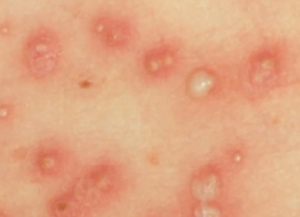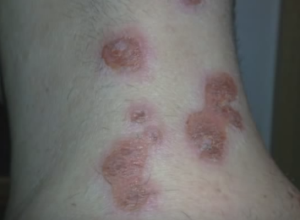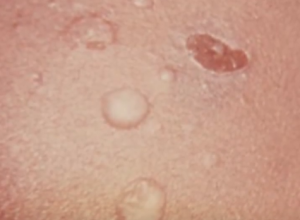Also called impetigo, infantigo is a very contagious infection of the skin that primarily affects children. It is commonly caused by the staphylococcus aureus and sometimes by the streptococcus pyogenes species. The infection is most common in children between ages 2 and 4 years. In fact, 70 percent of all infantigo cases are children. But people of all ages can also suffer from it.
Infantigo is not a severe condition and typically disappears on its own without medical treatment in about 2 weeks. Sometimes, oral and topical antibiotics may be prescribed by doctors to prevent the onset of complications.
Types and symptoms of Infantigo
Infantigo is classified into 2 types, viz.,
- Bullous infantigo which causes large, fluid-filled, and painless blisters
- Non-bullous infantigo which causes sores that rupture quickly and leave a yellowish brown scab. It is more common of the two.
Some of the signs and symptoms of infantigo are listed below:
- Development of reddish sores around the nose and mouth. These sores tend to rupture and ooze pus or fluid, eventually resulting in the formation of brownish-yellow, thick, golden crusts. The crust will dry and heal and leave a red mark which later disappears and does not leave any kind of scarring.
- The sores do not cause major pain, but tend to be very itchy. Parents need to take care and see that the affected children do not scratch or touch the sores as doing so can help spread the infection to other areas of the body as well as to other children and adults.
- Formation of fluid filled painless blisters on the arms, trunk, and legs. The surrounding skin tends to be itchy and red but is not sore. The blisters usually spread quickly and then rupture, leaving a yellowish crust in its wake. The scab will later heal and no scar marks are left.
- In severe cases, especially with bullous infantigo, patients may suffer from swollen glands and fever.
Causes of Infantigo
Infantigo is mainly caused due to infection by the Staphylococcus aureus bacteria. In rare cases, it may occur due to Streptococcus pyogenes bacterial infection. In colder regions, Staphylococcus aureus causes most infections, while both species of bacteria can infect people in warmer regions.
Both the above types of bacteria naturally occur on human skin without causing any harm. Infection occurs when the germs enter the skin via wounds or cuts, or due to presence of other skin conditions like eczema, etc., or even without any skin damage via direct contact with an infected person or infected items.
A toxin is produced by Staphylococcus aureus which facilitates the spread of the infection to surrounding skin. The toxin invades a specific protein that is responsible for keeping the skin cells bound to one another. Damage of this protein is what causes the bacterial infection to spread.
Children are more vulnerable to developing infantigo and elicit the associated symptoms as their immune are yet to develop completely.
Infantigo infection can begin in the below listed ways:
- Bacteria can gain entry and subsequently cause infection of the skin via direct cuts, scrapes, lesions, or wounds on the skin, or via skin damage caused by insect bites. Infection caused by this method is referred to as primary infantigo. It is mainly seen in children.
- Infection can occur due to underlying presence of some other kind of skin disease like dermatitis, eczema, scabies, etc., which has damaged the skin barrier. Infection caused by this method is referred to as secondary infantigo. It is more common in adults.
- Infection can also occur on healthy skin without any visible injury after the skin is exposed to direct contact with infected people as well as to things like towels, bed linens, clothing, and toys infected by a patient. Living in confined places and crowded environments, like barracks, etc., can increase the risk to developing infantigo in this manner.
The symptoms of infantigo make an appearance only 4 to 10 days after contact with the bacteria. People may pass on the infection to others during this period, and often do so, because they are not aware of their infected status.
Treatment of Infantigo
Treatment of infantigo is aimed at speeding the healing process, improving the appearance of the affected skin, and preventing the spread of infection as well as the onset of complications. Treatment is usually dependent on the intensity of symptoms and type of infantigo.
- Mild infections are usually treatable with basic personal hygiene and home remedies such as application of aloe vera gel, tea tree oil, turmeric paste, apple cider vinegar, eucalyptus oil, or lavender oil.
- Mild to moderate cases may be treated with:
- Topical antibiotics to be used on the infected skin after washing it warm soapy water. Healing occurs in about 10 days.
- If topical antibiotics do not yield results, then doctors may prescribe oral antibiotics. Pills are also given if infantigo is widespread.



